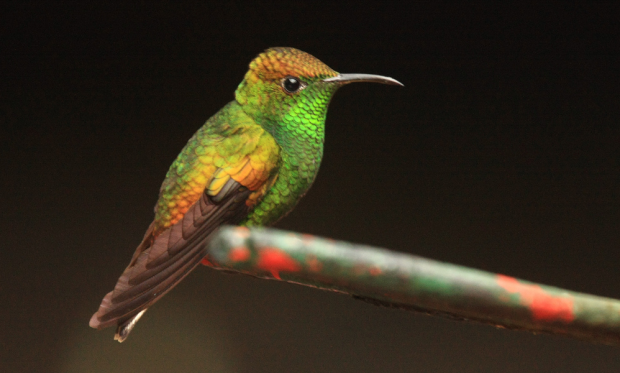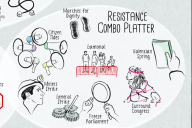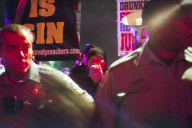Nostalgia, anxiety, and hummingbird pins.
I.
When someone dies, someone else always cleans up after. Someone enters a house, throws away sheets, gathers documents, compiles lists, makes phone calls, orders caskets, alerts neighbors, friends, long lost forgotten family members. Someone writes a eulogy and an obituary. Someone sweeps the floors. Takes out the trash. Puts the house on the market.
When someone dies someone always has to make the decision: get rid of that, keep this, ship this here, throw this away, give this away. Everyone always seems to own more than they ever remember.
II.
The pin is small but sharp, shaped like a hummingbird perched on a flower, faded and now black from the constant friction of my thumb and forefinger rubbing against it in my pocket. My therapist called it a totem. He suggested keeping something around—something physical—to transfer my anxiety to whenever it started to peak past the point of no return. Back then I was all anxiety: high-strung and jittery, drawing deep chest breaths and trying not to fall. In my pants pockets you could make out the bird if you looked hard enough: sharp and poking into my thigh, stabbing me with its bronze beak as if it were searching for nectar deep in the veins of my bloated thighs.
I am afraid to let it go, certain that when I do the last legacy of my grandmother will fade away, disappearing into the air like magic. This frightens me. My grandmother has been watching me my whole life: as a tube-ridden baby struggling to breathe, a precocious child with bouts of anger, a terminally shy pre-teen. She has loomed over me from high above, watching and waiting and guiding, and now, deceased, it is up to me, and the pin, to keep her presence alive.
Though I am not sure if the pin was even hers. I think it may not be a pin at all. I think, at one time, it might have belonged to a hummingbird feeder. I think my family may have gotten it after she died. I think it might not be hers at all. Maybe it is mine, or my mother’s, or my fathers’, or my brother’s, or my aunt’s, or my cousin’s, or maybe it belongs to someone else: someone that never knew my family, that never saw my grandmother. I think it might belong to everyone but her—anyone but her.
III.
At times I worry that the pin is a form of perverse nostalgia: a totem which represents, as critic Stuart Tannock puts it, “a positively evaluated past world in response to a deficient present world.” In Tannock’s argument of nostalgia, my grandmother’s pin is a misinterpretation of the past, embedded with positive memories in an attempt to “construct sources of identity, agency, or community, that are felt to be lacking, blocked, subverted, or threatened in the present.”
This seems right—painfully so, actually. After all, wasn’t the original function of this pin devised during a therapy sessions—its original purpose linked to a failing or lacking sense of mental stability? When I hold the pin I am doing more than grasping bronze: I am meditating and reflecting, fishing the happy moments of our shared and collective legacy from the stream of the past and thrusting them into the present. Or, is this wrong too? Is this just what I tell myself to put distance between the supposed trauma of her death, and its questionable importance in my continual development?
Either way, more questions are raised and never answered. Either way there is no easy answer, and each subsequent question leads me further down the messy rabbit hole of memory, longing, and nostalgia that has plagued me since my grandmother’s death.
IV.
The pin did not always mean what it means to me now. Objects take on a life of their own, their narratives unfolding in tandem with one’s own history. When my grandmother died there were items that were not willed away: great boxes of memorabilia littering rooms like innocuous secrets.
My mother and her siblings compiled these things on my dining room table, creating a smorgasbord of memory. The plan was simple: we would draw numbers and take turns picking from my grandmother’s trinkets till nothing was left. This was not about worth or value; all the marketable things had been distributed. What was left was nothing special: blankets, ID cards, pieces of jewelry, ceramic clowns, brooches, pins, documents, letters, a forgotten article of clothing or two. This was about memory and politics—a democratized attempt at allowing an extended family equal access to the memory of my grandmother.
Few things are one-hundred-percent democratic. There are always exceptions. My brother and I snuck picks, making backroom deals with my mother in our cramped laundry room for the two plush clown dolls, which were given to us exclusively by our grandmother, but had somehow found their way onto the freebie table. Other things were more-or-less of the table: a watch which stopped right at my grandmother’s death was held onto by my aunt, blankets with hummingbirds on them, though free to everyone and highly sought after, somehow wound up in our family home, and surely jewelry—not willed but still desired—ended up resting on my aunt and mother’s dressers.
However, things were still chosen. Our small family made careful circles around the table, circling the cream faux-marble with hungry eyes and delicate fingers. As the clock ticked the pile shrunk. Certain things weren’t chosen at all, and others were picked through gut reactions and racing hearts. What I ended up with was more-or-less unremarkable: a blue and white brooch, an ID photo from my grandmother’s time at Compaq, a blanket, a couple of clown figurines missing arms or legs, and, of course, the pin.
V.
When I hold the pin I am doing more than grasping bronze: I am meditating and reflecting, projecting my shared past into the present in an attempt to calm my nerves. In an article by Ray Cashman, titled “Critical Nostalgia and Material Culture in Northern Ireland,” Cashman argues for a more constructive, or positive, reading of nostalgia. As he puts it, “nostalgia extends beyond the realm of imagination as a structure of feeling into the realm of action or practice,” and in a way I agree. The idea that nostalgia is not an illness but an active process of self-construction in which the intangibility of memory and feeling are enveloped into the person or society, is comforting to me as I struggle with the silliness of this all.
In this version of things, I am not simply succumbing to nostalgia, but using it as a stepping-stone in the crafting my own identity. This would uphold the principle my therapist was hoping for: using the object as a totem for stress—transferring negative energy into a physical place to compartmentalize it and deal with it logically and orderly. However, whereas my therapist imagined this as a one-way street, I have opened it up, allowing things to flow two ways: from pin to self, and from self to pin.
This could be dangerous. As Elliot Oring defines it, personal identity is a construction of “memories, identifications, and repudiations of individuals, ideas, and experiences which come to constitute a perhaps shifting, but nevertheless discernible, configuration.” In this process of recollection, I am straining the final configuration of myself: squeezing and prodding at it with my grandmother’s memory in a vain attempt to make myself feel more complete.
Alternatively, I am doing something worse: I am disturbing the discernible configuration that was my grandmother, manipulating her form with false memories to shape my present worldview. In this version of things, the past does not just affect the present, the present affects the past, and nothing is left unspoiled.
VI.
When I am upset I can stroke the pin and recall my grandmother’s death. It is a strange thing to recall, but there is comfort in the clarity; something welcoming in the remembering, with perfect precision, a memory so far removed.
In a cramped second-story room in Bellaire Texas, my grandmother is dying. My mother is lingering near the corner, after ushering my brothers and I into the room to say our final goodbyes. The room is coral, a soft shade of pink, which, bathed in the amber glow of the table lamp, seems impossibly hot. I make the trek up to the bed, counting each step from the door to my grandmother with anguish. And then there is the action: the bending, the sensation of hot flesh, dapped in bits of cold salty sweat, pressed against pink lips, and then nothing, and then silence.
When I am nervous or sad or angry or lonely I will recreate this scene: fishing the bronze pin from my pocket or desk and pressing it gently against my lips. But it is never the same; it is never enough. The pin is cold and metallic against my lips, and my fingers are much too big and I am much too tall and the room is too big or too cold or too white or brown or blue or any color in between. Nothing is ever the same. Everything is a totem of something else: a symbol of something long gone, grown black and faded from too much rubbing.
VII.
Everything is rooted in the past; few things are wholly bright and new. Folklorist Barbara KirshenBlatt-Gimblett theorizes that “[h]eritage is a new mode of cultural product in the present that has recourse to the past” and exists “prior to its identification, evaluation, conservation, and celebration.” As I interpret it, heritage does not come from contemplation, but is embedded in the very process of contemplation. Similarly, KirshenBlatt-Gimblett discusses how the heritage industry creates “the attribution of pastness” which “creates distance[s] that can be traveled.” In this theory my grandmother’s pin is not a false idol tarnished with nostalgia, but an agent of the larger heritage industry through which I can traverse the large distance of the past, and reflect on the traumas and comforts embedded deep within.
My recollection, under this guise, is a form of heritage building: instilling my grandmother’s death as a central moment in our shared history—a moment of simultaneous connectivity and remorse which is brought into the present in an effort to qualm my out-of-sync emotions. I am remembering, and consciously changing, the past traumas: drawing out the hidden intimacies, bitter sadness, and the overwhelming loneliness deeply embedded in that memory.
VIII.
When my grandmother dies I feel more alone than I have ever felt before. When my first boyfriend leaves I feel lonelier than that. Mid-summer and stuck in my bedroom I pace the floor making dark marks in the carpet. The third-story room is sweltering. The air conditioner is old and barely working and beads of sweat pool on my forehead and body. Unlike my grandmother, there is little physical trace of my first boyfriend when he leaves, just faint memories and reflections. The sole physical object that remains from him is a contact lens that the summer heat has fused to my bathroom counter.
In the deepest moments of my loneliness, I stand in front of the mirror and look down: staring at a melted contact lens and scrapping at it furiously with my fingers and keys. I want it gone. I want to be wholly alone: no noise, no people, no breathing. I want to trace thick grooves into the walls and etch dark marks into the floor. I want to be hungry and tired and skeletal as the dead. I want to bathe myself in a loneliness so hot it blisters the skin.
Sometimes I think loneliness is like a cancer: slow to start and creeping, clawing and winding its way through the body and the blood infecting everything it touches, turning it straight to black. I wonder if you can track loneliness, or eradicate it completely, or is it like being in remission: gone today, but here tomorrow? How long can loneliness lay dormant? I wonder if it is genetic, if it can be passed from person to person, if it is airborne, or sexually transmitted.
I wonder if my grandmother was lonely before she died.
I hope she wasn’t.
IX.
Nothing has power unless you give it power. In their Theory of Literature, Rene Welleck and Austin Warren give the concise definition of a symbol as being an object that stands in for another object, but demands merit on its own. The sign is given its power by the signer—it does not stand alone.
Rachel P. Maines and James J. Glynn say something similar, suggesting that “the emotional force of association objects is their validation of memory and physical connection to the past.” Objects hold no real power of their own. Instead their power is derived from whether or not they provide an accurate validation of memory. My grandmother’s pin therefore does not have power or connection to her own existence. My grandmother’s pin is a relic of the past, an object I can cling to, which connects me to, and validates, a specific past I have created in my mind.
But, the symbol of my grandmother’s pin does have power—or at the very least, demands reverence. In this version of things, what is important is not the object—that could be anything—but my willful attachment of emotions to the object. In this account, my grandmother is not strong enough to reach through the thicket of time and link us together. Rather, I am foolish enough to clear a path through the thicket, to thin the brush just enough to squint through.
X.
It is not as serious as it seems. Nothing ever is. Things are all high drama and part fiction. The truth lies somewhere in between: nebulous—but who needs it anyways? Months after my therapist first tells me to use the object for my anxiety, its purpose has been exhausted. I find myself staring at the tiny bird, stroking it and wondering if I’ll ever have the same emotional attachment again.
Here are the chronological facts as they happen. One: when this feeling first strikes I am about to enter my final semester of college. Two: I am at the tail end of another horrible, and sweltering, summer. Three: I am attempting to “fix things” with my first boyfriend but, of course, this is not going well. Four: I am seeing another boy—barely. Five: I have just gotten over a two-week sickness or nervous breakdown brought on by the combination of the above factors. Six: my apartment catches on fire.
Huddled on my friend’s too-small couch and smelling of smoke, I cannot sleep. My mind is circling in on itself: reliving the fire, the moments spent with my first boyfriend, me quitting my job, my first “date” with the new boy, my coming graduation, my therapy visits, my grandmother’s death—nothing is off limits. In the dark I am counting the minutes as they pass, waiting for the morning when I’ll be forced to return to the smoke-filled remains of my apartment, collect all of my belongings, and rush to find an available apartment before the start of a new semester.
When we’re first allowed back into the apartment—to grab just a few things for the night—my brother fishes through the dark and finds the hummingbird pin, pushing it into my hands and giving me an understanding look. I feign a smile, pretending that the pin is still important to me. Throughout the night I struggle to conjure up the same calming feeling the pin gave me before, stroking it, holding it, examining it in the low light of the night, but nothing works. I am scared that it has lost its power.
The next morning we clean out the apartment. We work all day and get most of it boxed up and packed away. I am covered in sweat. In the parking lot the boy I have been seeing rides by on his bicycle and I hide my damp and smoky body in shame.
When we empty out the apartment I take a last look at the husk of the building and try and hide my tears. It looks like a bruised skeleton: parts of it are stained dark black, doors are kicked in, windows are broken, plywood covers rooms where the damage has proven too terrible to allow entry. Sweaty moms and dads, college students, and friends are all moving furniture up and down the stairwells. Boxes pour out of open apartments. Our dumpster overflows with items no longer needed.
In the vast emptiness of the apartment I am simultaneously reliving my grandmother’s death and recreating my morning ritual. I am in two places at once, and in the absence of all objects, I am free from loneliness or sorrow or the harsh constraints of memory. In the barren room, I am in charge of assigning value—nothing exists to guide me along. I reach into my pocket to stroke the pin, but this too is gone; no doubt tucked away in the messy column of boxes now stacked on my father’s truck bed.
For a second I panic, but this feeling disappears. This time, I do not need the pin to help me with the end. This time, I do not want relive the past. Somewhere in time, my grandmother is still dying, and my first boyfriend is leaving, and my apartment is not on fire, and I am not graduating or leaving or moving, just standing still and watching. But then, I set things in motion: I take a step out the door, and in the past, this motion is reciprocated. And so we go, step by step, towards the end, away from the end, moving forward, growing—never looking back.
Further Reading:
- Stuart Tannock, “Nostalgia Critique” in Cultural Studies, 9:3 (1995)
- Ray Ashman “Critical Nostalgia and Material Culture in Northern Ireland” in The Journal of American Folklore 119:472 (2006)
- Elliot Oring, “The Arts, Artifacts, and Artifices of identity” The Journal of American Folklore, 107:424 (1994)
- Barbara Kirshenblatt-Gimblett “Theorizing Heritage” ethnomusicology 39:3 (1995)
- Rene Wellek and Austin Warren “Theory of Literature” Harcourt, brace and Company, NY (1949)
- Rachel P. Maines and James J. Glynn “Numinous Objects” The Public Historian 15:1 (1993)
Photo by Seabamirum.


















